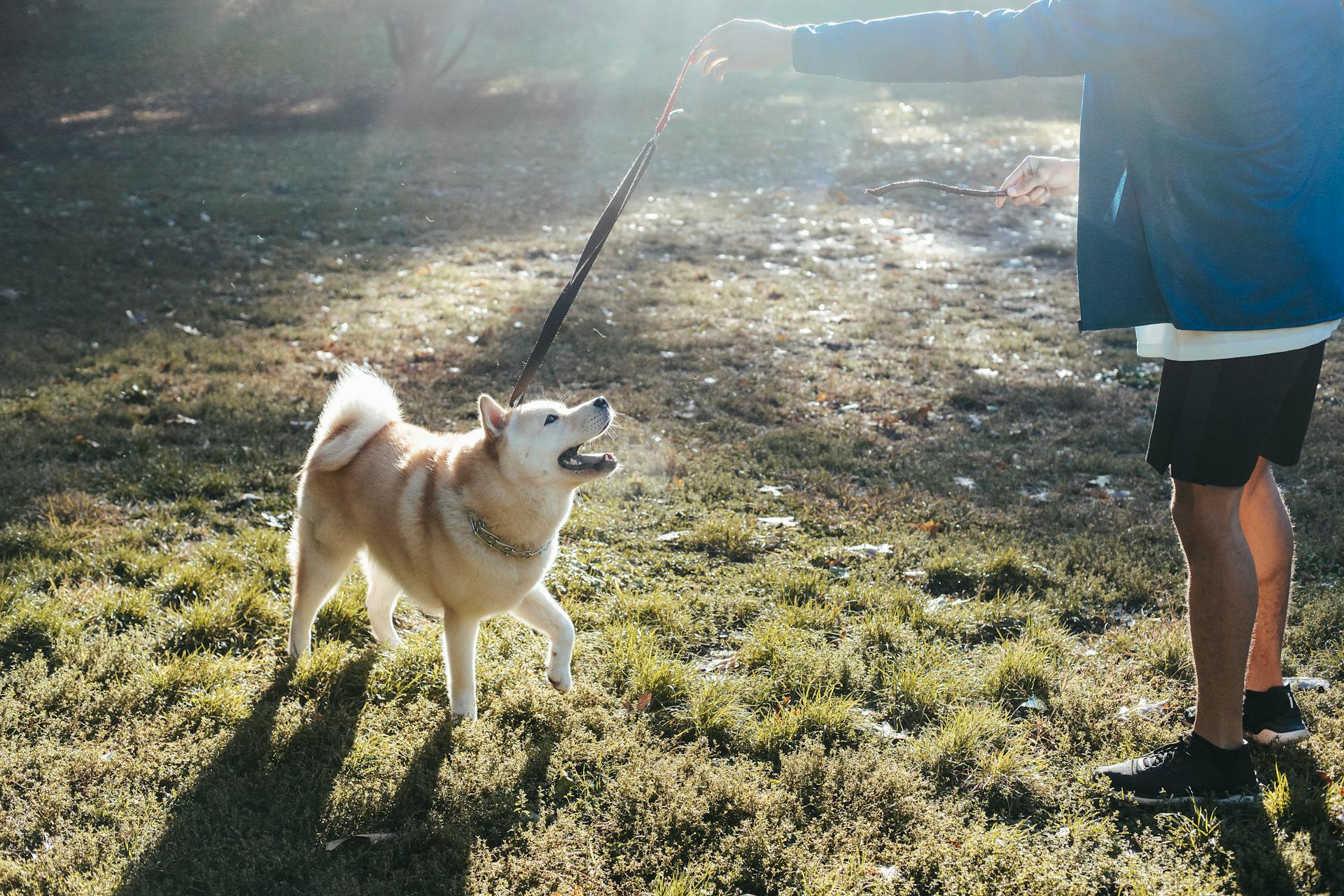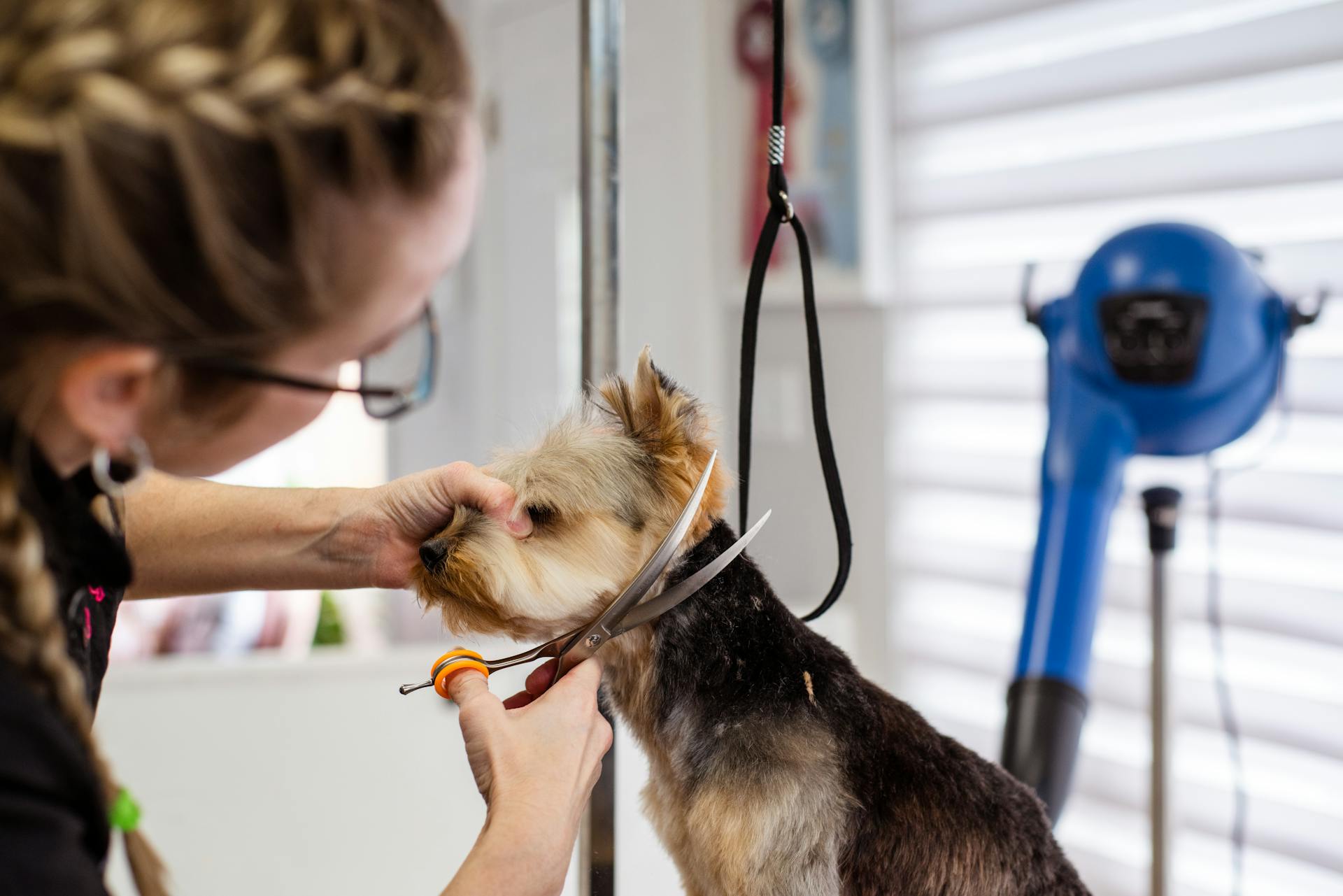
Starting a dog training business requires a solid plan, just like any other venture.
Research your market to understand the demand for dog training services in your area. This can be done by analyzing online reviews, talking to pet owners, and identifying local dog training businesses.
A well-written business plan is essential for securing funding and setting clear goals. It should include a detailed description of your business, target market, and financial projections.
A typical dog training business can charge anywhere from $50 to $100 per session, depending on the type of training and the trainer's expertise.
Business Planning
Starting a dog training business requires a solid plan to succeed.
Identify your target market, which can be local dog owners or a specific breed of dog.
Research local competition, including other dog trainers and pet stores, to understand the market demand and pricing.
A business plan should also outline your services, including group and private training sessions, as well as any additional services like puppy socialization classes.
Set clear goals and objectives, such as the number of clients to acquire within the first six months, to measure your business's progress.
Partnerships
Partnering with local businesses can help increase your visibility and reach a wider audience. Partner with local pet shops, vets, or dog shelters to increase your visibility.
Leaving business cards or brochures at their locations can be an effective way to spread the word. You can also offer exclusive discounts to their customers to incentivize them to try your services.
Organizing joint events or cross-promotions can be a great way to collaborate with other businesses and create a buzz around your brand. Consider co-hosting a pet adoption event or a dog training workshop with a local shelter or pet store.
Consider reading: Pet Paradise Dog Training
Choosing a Concept
Choosing a concept is a crucial step in becoming a dog trainer, as it will define your training style, services, and clientele. It's like deciding on the unique approach or philosophy you want your business to embody.
This decision will influence your branding, marketing, location, and even the types of classes or programs you provide. A well-defined concept can help you stand out in the market and draw in pet owners who are looking for the specific services you offer.
Let's take a look at the most popular dog training concepts:
Each of these concepts has its own unique approach and target audience, so it's essential to choose the one that best fits your business goals and values.
Pursue a Certificate
Pursuing a dog training certificate is a crucial step in becoming a certified dog trainer.
You can gain expertise through a certificate program that you might not otherwise obtain through work experience.
There are no state or federal requirements to becoming a dog trainer or owning a dog training business.
Becoming a member of and gaining certification from credible organizations, such as the Association of Professional Dog Trainers (APDT), can show your clients that you have the knowledge and experience to deliver results.
Apprenticing with other professional dog trainers or volunteering at your local animal shelter can provide hands-on experience and help you develop your skills.
Learning multiple dog training techniques is essential, as one technique might work for some dogs but not others.
Gaining a certificate can also give you a competitive edge and make you more attractive to potential clients.
For your interest: Dog Training Schools for Trainers
Wise
Wise is a company that understands the importance of effective training in dog obedience. They have a team of professionals who research, train, and work together to create free dog training business plans.
Their team is dedicated to meeting individual client needs in a timely and courteous manner. This attention to detail and commitment to customer service is a hallmark of Wise's approach.
Wise's team of experts conducts careful market research to understand the client base and potential sources of continuing cash flow. This research helps them formulate a personalized business plan for achieving success.
By understanding the client's needs and goals, Wise's team can create a tailored plan that addresses their specific challenges and opportunities.
Setup and Licenses
Setting up a dog training business requires careful planning and compliance with various regulations. You'll need to choose the right business structure to protect your business and determine your tax obligations.
To operate a dog training business, you'll need to obtain the necessary licenses and permits, which may vary by location and services offered. This typically includes a business license, specialized permits related to pet care and handling, and compliance with zoning laws.
A general business license from your city or county is usually required, as well as a kennel license if you plan to board dogs. You might also need a special animal training permit or a sales tax permit if you're selling products. It's essential to consult with your local government or a legal professional to understand the specific requirements for dog trainers in your area.
You'll also need to adhere to animal welfare laws and guidelines, which include providing humane treatment, proper handling, and ensuring the safety of the dogs during training sessions. Non-compliance with these laws can have serious consequences, including fines, license revocation, and even criminal charges.
To protect your business, you should consider obtaining general liability insurance, property insurance, and professional liability insurance. If you have employees, workers' compensation insurance is typically mandatory to cover work-related injuries or illnesses.
Here's a breakdown of the typical licenses and permits you'll need to obtain:
The specific requirements for dog trainers can vary depending on your location, so it's crucial to research and comply with the regulations in your area. By understanding and meeting these requirements, you can focus on what you love most – training dogs – while maintaining a responsible and legally compliant business.
Financial Planning
Establishing a clear and comprehensive budget is vital when starting a dog training business. You'll need to consider costs such as rent or a mortgage, utilities, vehicle expenses, insurance, training equipment, and marketing.
The initial capital needed to become a professional dog trainer can range from $2,000 to $30,000, depending on the scope of your business and location. A home-based operation can start with as little as $2,000, while a more comprehensive training facility can require upwards of $30,000.
To create a budget, include items such as rent or mortgage, utilities, vehicle expenses, insurance, training equipment, employee salaries, certifications and courses, software, and marketing. It's also essential to keep your personal and business finances separate by opening a business bank account.
The size of the training facility and location can significantly impact startup expenses. A larger space requires more equipment and higher operational costs. Prime locations in high-traffic areas tend to have higher rental costs.
For your interest: Dog Training Insurance Uk
Here are some tips to help you create a budget for your dog training business:
- Start with basic training tools and upgrade as your business grows.
- Consider a mobile dog training service to reach clients directly.
- Offer a focused range of services to reduce the need for extensive equipment and space.
- Handle administrative tasks, marketing, and training sessions yourself to save on labor costs.
- Use low-cost marketing strategies like social media, community bulletin boards, and word-of-mouth referrals.
The minimum budget for starting a dog training business can be around $1,000 to $5,000 if you choose to work from home, minimize the size of your operation, and manage much of the work yourself.
A different take: Crate Training Schedule for Working Owners
Marketing and Promotion
To effectively market and promote your dog training business, it's essential to encourage satisfied customers to leave reviews on platforms like Google, Facebook, or Yelp. This can be done using tools like Clicks! With Digiwoof, which allows you to automate review requests as part of your workflow.
You can also leverage social media to your advantage by streamlining your social media management with tools like Clicks!. This enables you to schedule posts and engage with your audience automatically, boosting your interaction rates and maintaining a consistent online presence.
By understanding your target audience, you can tailor your services to meet their specific needs and preferences. For example, if you're targeting busy professionals, you might offer flexible training schedules or intensive weekend workshops. Here are some potential customer segments for your dog training business:
Client-Focused Messaging
Crafting client-focused messaging is a crucial aspect of marketing and promotion for your dog training business. Your messaging should resonate with your target audience and compel them to take action.
To create effective messaging, consider the specific needs and preferences of your target audience. If you're targeting busy professionals, for example, you might focus on flexible training schedules or intensive weekend workshops.
Your messaging should speak to the needs of both your clients and their pets. By understanding what problems your services can solve, you can tailor your messaging to resonate with your target audience.
Here are some potential client segments and their corresponding preferences:
By understanding your target audience and tailoring your messaging to their needs, you can create a compelling and effective marketing strategy for your dog training business.
Soliciting Reviews:
Soliciting reviews from satisfied customers is a crucial step in building a strong online presence. Positive reviews can significantly influence potential clients.
Encourage your clients to leave reviews on platforms like Google, Facebook, or Yelp. Tools like Clicks! With Digiwoof allow you to automate these review requests as part of your workflow.
Automating review requests can save you time and ensure consistent messages. Designing customizable review request templates helps you maintain a professional image.
Timely follow-ups are key to maximizing the chances of receiving valuable feedback. You can automatically send review requests when packages are completed or classes end.
Positive reviews not only enhance your reputation but also improve your SEO, making it easier for potential clients to find you online.
Online Courses & Communities
The Clicks! mobile app is a game-changer for dog trainers, allowing you to manage your business on-the-go. With the app, you can access and update client information, track leads, and manage your customer relationships from anywhere.
You can schedule and manage appointments directly from the app, keeping your calendar up to date and ensuring you never miss a session with your clients. This feature is a huge time-saver and helps you stay organized.
The app also enables you to create and send invoices, collect payments, and use tap-to-pay and POS features directly through the app. This simplifies your financial management and ensures timely payments from your clients.
To create engaging online courses, Clicks! provides a dog trainer-friendly course builder, flexible bundling options, and customizable subscription and payment plans. With this tool, you can design and structure your online courses with ease, creating informative content tailored to your dog training expertise.
By offering online courses, you can expand your services and revenue, reaching a broader audience and showcasing your expertise. You can promote and sell your courses using integrated marketing tools and e-commerce features, making it easy to generate revenue.
Here are some key benefits of creating online courses:
- Expand your services and revenue
- Reach a broader audience
- Showcase your expertise
- Generate revenue through e-commerce features
By leveraging the Clicks! platform and creating engaging online courses, you can take your dog training business to the next level and stay ahead of the competition.
Social Media Management
Social media management is a crucial aspect of marketing and promotion. It allows you to streamline your online presence and focus on what you do best.
With tools like Clicks, you can schedule posts, reels, and carousels to Instagram, Facebook, TikTok, and Google Business. This helps you maintain a consistent online presence effortlessly.
You can also trigger automations off of a comment or a message. For example, when someone comments the word "puppy", they get sent a personalized message.
Engaging with your audience automatically can boost your interaction rates.
Here's an interesting read: Online Dog Training Academy
Referral Program
Develop a referral program that offers incentives to customers who refer your services to their friends or family.
This could be a discount on their next training session or even a free session if they refer a certain number of clients.
Marketing is all about connecting with your potential customers and building relationships.
Your passion for dogs and commitment to their well-being should shine through in your marketing efforts.
With a little creativity and consistency, your dog training business will surely thrive.
A fresh viewpoint: Dog Training Marketing
Branding and Unique Selling Proposition
Your brand is more than just your business name or logo, it's the experience your clients get when they engage with your business. Consider what makes your dog training business unique and how you want to be perceived by your potential clients.
To create a strong brand, think about what sets you apart from the competition. Do you specialize in training service dogs? Are you great at helping problematic dogs? Or perhaps you use unique training methods? This uniqueness becomes your Unique Selling Proposition (USP), which differentiates you from your competitors.
Your USP can be a game-changer in marketing and promotion. It's what will resonate with your target audience and compel them to take action. By emphasizing your USP, you can create a strong brand identity that attracts and retains clients.
Effective branding is all about highlighting what makes you unique. By doing so, you'll stand out in a crowded market and attract clients who value your specialized services.
A different take: It's Your Choice Dog Training
Naming Options
You have two main options to consider when choosing a business name: including your name or creating a separate identity for your business.
If you want to build a brand around yourself, including your name in the business name can be a good idea, but it's essential to keep it catchy and descriptive, like "Joe's Pawsitive Training".
A business name that doesn't include your name, such as "Empowered Puppy Training", can scale with or without you, making it a great option if you plan to grow your business.
You should focus on creating a name that's easy to recognize and understand what your business does, avoiding abstract names that might confuse customers.
Operations and Management
To establish a smooth operation, consider implementing a Client Relationship Management (CRM) system tailored for dog trainers. This system should integrate scheduling, client information, and session notes.
A CRM system with online booking can save time and reduce back-and-forth communication typically required for booking appointments. This convenience is especially beneficial for clients who can schedule sessions directly through your website or app.
To manage your training programs, look for software that can help you design and monitor individual training plans. The best systems enable you to customize training modules and track the progress of each dog.
Regularly tracking inventory levels, especially for training aids, treats, and equipment, is essential to avoid any disruption in your training sessions. A system that alerts you when supplies are low can help you order supplies proactively.
Discover more: Dog Diaper Training
What Services Will You Offer?
As you start planning your dog training business, it's essential to decide on the services you'll offer. Selecting the right mix of services is key in shaping your business.
You have a wide array of services to choose from, including basic obedience training, specific behavior modification training, agility training, puppy training, and more. From therapy dog to service dog training, you can tailor your services to fit your skill set best.
Your goal should be to find a niche that sets you apart from other businesses. This will be different for every trainer, based on your area, local competition, and your skillsets. Avoid copying your competition, as this will make you a commodity and the only way to win is to be the lowest price.
Offering ancillary services like dog walking or pet sitting can provide additional income streams that supplement your core training business. You can also consider offering specialized services like behavioral modification training, which focuses on changing specific behavioral issues.
To determine the services you'll offer, you can start by considering the most popular dog training concepts, including Positive Reinforcement Training, Behavioral Modification Training, and Puppy Training Classes. Each concept caters to a specific audience and can help you stand out in the market.
Here are some of the most popular dog training concepts:
By choosing the right services and concept, you'll be able to attract the right clientele and differentiate your business from the competition.
Daily Operations
To ensure smooth operations, consider adopting a Client Relationship Management (CRM) system tailored for dog trainers, which integrates scheduling, client information, and session notes.
A CRM system with online booking can save time and reduce back-and-forth communication typically required for booking appointments.
You'll also want software that helps design and monitor individual training plans, allowing you to customize training modules and track progress.
Inventory management is crucial, even for dog trainers, to keep track of training aids, treats, and equipment, and to alert you when supplies are low.
Establish clear communication with clients from the start, setting expectations for training outcomes, session schedules, and payment terms.
A happy client is more likely to refer others to your services, so maintaining a good rapport is essential.
Providing regular training and setting clear goals for assistants or staff can boost morale and encourage a team-oriented atmosphere.
Recognizing achievements can make a big difference in maintaining a healthy work-life balance.
Train staff to be patient, attentive, and supportive, personalizing each session by remembering the dog's name and specific behavioral goals.
A clean and safe training environment, with clear signage and an organized layout, will enhance the experience for clients and their pets.
Implement customer service policies that reflect the values of your dog training business, including satisfaction guarantees and clear policies on cancellations and rescheduling.
You might enjoy: Dog Training Goals
Hire the Right People
Hiring the right people for your dog training business is crucial for smooth operations and high-quality service. You'll need experienced dog trainers who are adept at using positive reinforcement techniques and can handle a variety of dog breeds and temperaments.
For the training aspect, prioritize candidates with a mix of practical experience, certifications from recognized dog training programs, and a passion for working with animals. A head trainer with a strong background in animal behavior and training methodologies is crucial to set the standard for your services.
Administrative staff will handle client communications, scheduling, and record-keeping. Look for organizational skills, experience with customer service, and familiarity with scheduling and record-keeping software.
A manager or owner-operator will oversee the business, manage staff, and handle administrative duties, including marketing, financial management, and compliance with local regulations. Seek candidates with experience in business management, a strong understanding of the pet services industry, and leadership qualities.
Curious to learn more? Check out: Dog Daycare Staff Training
Here's a breakdown of the key job positions and their average monthly gross salary:
To ensure a good fit for your dog training business, consider practical assessments during the hiring process, such as conducting a mock training session or having candidates interact with dogs under supervision.
Contract Management
Contract management is a crucial aspect of running a dog training business. You want to make sure your contracts are clear and transparent for both you and your clients.
Developing comprehensive digital contracts with initials throughout the documents can help ensure clients read and understand each section. This is especially important for dog training businesses, where clear communication is key.
Automating the contract process can save you time and effort. Clicks! can help you send contracts as part of client onboarding, set up reminders, and send thank you emails upon contract completion.
To create a solid contract, you'll want to include requirements for signatures from both the client and the trainer. This ensures a complete agreement and transparency for all parties involved.
Consider reading: Dog Training Away from Home
Here are some essential elements to include in your contracts:
- Initials throughout the document to ensure clients read and understand each section
- Signatures from both the client and the trainer
- Reminders and thank you emails upon contract completion
By having a well-structured contract management system in place, you can build trust and clarity with your clients, and ensure a smooth and professional experience for all.
Choosing a Location
When starting a dog training business, you have the flexibility to choose where to operate. You can run it out of your home, making house calls, or even setting up a dog training center.
There are various options to consider for a location. You can start a dog training business in a commercial space or in the comfort of your own home.
Running your business from home can be a convenient option, but it's essential to ensure you have enough space for equipment and potential clients. You can also make house calls, visiting clients in their homes, which can be beneficial for those with busy schedules.
Ultimately, the choice of location will depend on your business goals and the services you plan to offer.
Gain Experience
Gaining experience is a crucial step in building a successful dog training business. You should spend a lot of time with dogs before starting your own business.
Many dog trainers have had some training experience prior to starting their business. In fact, it's a good idea to gain experience in various roles, such as pet sitting, dog walking, dog grooming, or even dog show handling.
To get started, consider volunteering to be a pet sitter for friends, family, or even local shelters. This will give you hands-on experience caring for dogs in a home environment.
As a dog walker, you'll have the opportunity to interact with dogs in a more active setting. This can be a great way to build your endurance and learn how to handle dogs in different situations.
Dog grooming is another valuable experience to have. You'll learn about different breeds, their specific grooming needs, and how to handle dogs in a grooming setting.
Dog show handling is a more specialized experience, but it can be a great way to learn about different breeds and how to handle dogs in a competitive setting.
Here are some ways to gain experience:
- Pet sitter
- Dog walker
- Dog groomer
- Dog show handler
Frequently Asked Questions
Can you make 6 figures as a dog trainer?
While average salaries for dog trainers are around $44,910, leadership roles and self-employed trainers can earn upwards of $60,000 to $70,000 per year, potentially reaching six-figure incomes with experience and strong marketing skills. However, reaching a six-figure income as a dog trainer requires specialized skills, experience, and business acumen.
Is dog training a good investment?
Yes, dog training is a worthwhile investment that can prevent costly vet bills and other expenses associated with untrained dogs. By investing in training, you can save money and ensure a safer, more enjoyable experience for both you and your pet.
How do I write a dog training plan?
To create a comprehensive dog training plan, start by defining your goals, identifying the desired behavior, and outlining the training process, including the trainer, location, and timeline. A well-structured plan will help you achieve your short-term and long-term objectives and strengthen the bond with your dog.
Sources
- https://digiwoof.com/how-to-start-a-dog-training-business-in-2023/
- https://dojobusiness.com/blogs/news/dog-trainer-complete-guide
- https://www.petexec.net/post/how-to-start-a-dog-training-business
- https://www.theacademyofpetcareers.com/blog/starting-a-dog-training-business/
- https://wisebusinessplans.com/start-dog-training-business/
Featured Images: pexels.com


